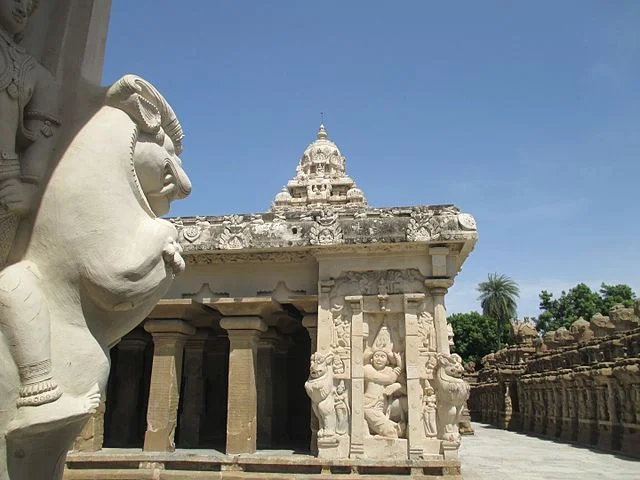Kailasanathar Temple, located in Kanchipuram, Tamil Nadu, is one of the finest examples of early Dravidian architecture. Built during the Pallava dynasty, this temple dates back to the 7th century AD. The Pallava king, Narasimhavarman II (Rajasimha), commissioned its construction, and it remains one of the earliest stone temples in South India.
Get your dose of History via Email
Architectural Significance

Kailasanathar Temple is renowned for its distinct architectural style. It was constructed primarily using sandstone, which allowed the detailed carvings that adorn the temple walls. These intricate sculptures depict scenes from Hindu mythology, showcasing various gods, goddesses, and other mythological beings.
The temple follows the typical Dravidian style of architecture with a pyramidal tower, or “vimana,” over the sanctum sanctorum. The sanctum houses the primary deity, Lord Shiva, in the form of a lingam. The temple complex also includes a series of small shrines dedicated to other deities, arranged around the main structure.
Influence on Later Temples

Kailasanathar Temple significantly influenced later South Indian temple architecture. Its unique style and the use of stone set a precedent for other temples in the region. The temple’s layout, with its central sanctum and circumambulatory path, became a standard for many subsequent structures.
The sculptures found at Kailasanathar Temple also inspired later artistic developments in the region. The detailed stonework and representation of mythological stories were replicated in temples throughout Tamil Nadu, marking a shift from earlier brick-based structures to stone constructions.
Historical Context

The temple was built during a period of political and cultural prosperity under the Pallavas. Kanchipuram, where the temple is located, was a major center for religion and learning during this time. The Pallavas were great patrons of art, architecture, and learning, which is reflected in their temples. The construction of Kailasanathar Temple during Narasimhavarman II’s reign signaled the peak of Pallava architectural achievement.
Preservation and Restoration

Over time, the sandstone used in the construction of Kailasanathar Temple has weathered, leading to the erosion of some of the intricate carvings. However, efforts to preserve and restore the temple have been ongoing. The Archaeological Survey of India (ASI) has undertaken several projects to protect this historical monument, ensuring that future generations can appreciate its significance.
The temple continues to function as a religious site, attracting both pilgrims and tourists. Although some of its carvings have been damaged by time, the temple’s grandeur remains evident. The restoration efforts aim to preserve both its religious importance and its status as an architectural masterpiece.
Conclusion
Kailasanathar Temple is a crucial example of early Dravidian architecture. Its construction during the Pallava dynasty marked a significant advancement in South Indian temple design. The temple’s influence on later constructions and its enduring religious significance underscore its importance in Indian history. Preservation efforts have helped maintain its historical and architectural value, ensuring that this landmark continues to inspire awe.
Source:

